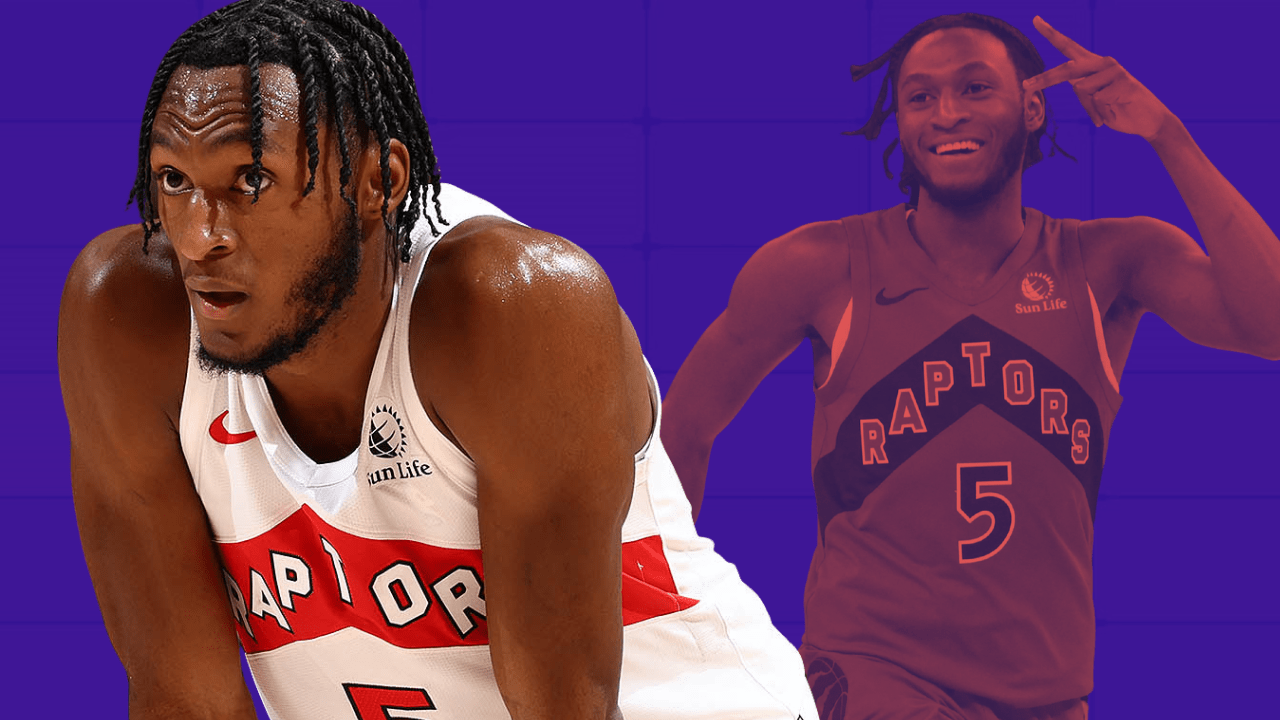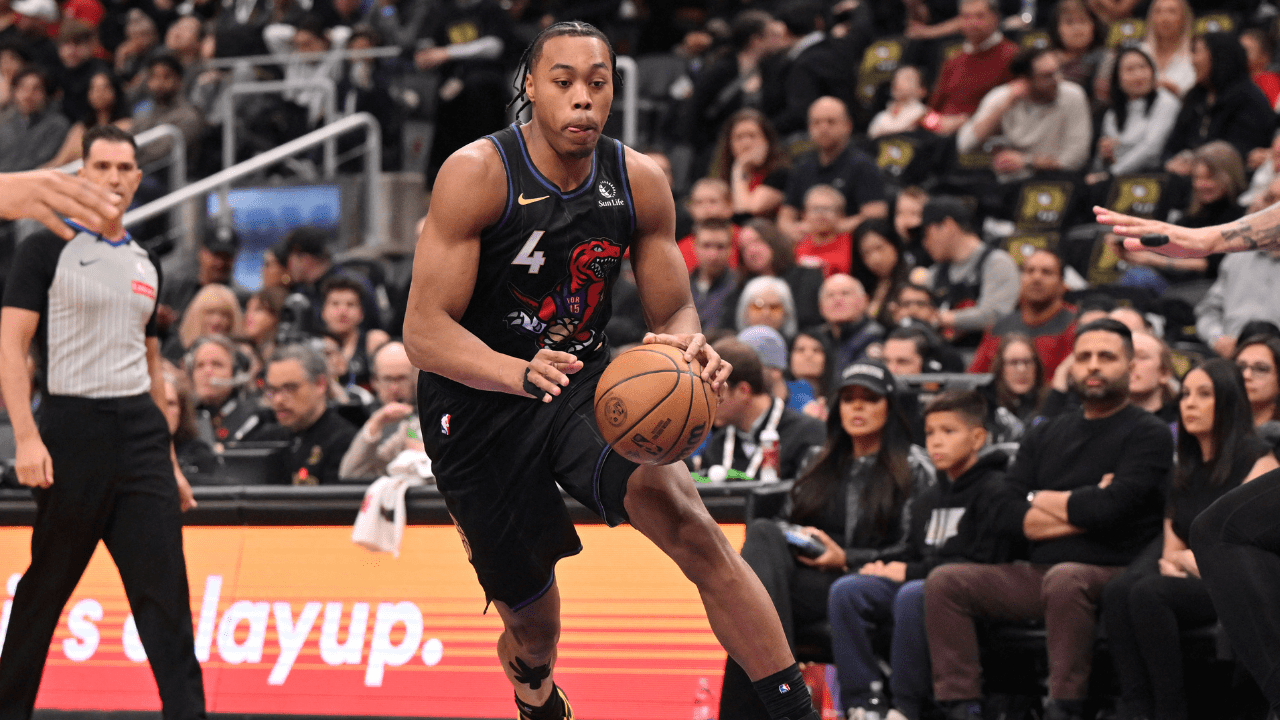This is a part of an off-season series by Esfandiar Baraheni, breaking down one skill for each Raptor heading into the 2025-2026 season that could change their career. Check out the video below.
Immanuel Quickley’s injury-riddled 2024-2025 season came at an unfortunate time. After getting his payday, Quickley was supposed to take a leap in his career. The Raptors held a press conference in the summer of 2024, announcing the extensions of Quickley and Scottie Barnes to the slogan “The Future Is Now,” but both players fell short of those lofty expectations the following year.
The conversation league-wide has been that Quickley’s contract was hefty, the Raptors are expensive without any real intention to contend, and as a result, the consensus is to be pessimistic about the Raptors’ future.
Barnes plays a big part in that. The Raptors will go as far as he takes them. As the focal point of everything they’re building, he has to continue to evolve in order for the team to follow suit.
But the same thing applies to Quickley to a lesser degree. While the contract conversation is overblown (He gets paid 21% of the cap next season and will be making around 16% of the cap in his final year), he has to perform to a standard that makes it feasible for him to be paid like the starting point guard of the team.
And ultimately, the presence of Brandon Ingram has shifted the Raptors’ team-building pecking order. Much like RJ Barrett, Quickley has moved down a spot in the totem pole, and his role will change in short order. How he adapts to that will be the determining factor of the next few seasons of Quickley’s career, and it has a massive impact on the Raptors’ team-building both in the short and long term.
Simply put: If Quickley is good, life for the Raptors will be a lot easier.
Like water in the desert, Quickley provides something the Raptors desperately need: three-point shooting.
Specifically, he’s by far the best pull-up shooter from distance on the team. Of 40 players who attempted more than three pull-up 3’s a game, Quickley was fifth in efficiency last season, shooting 38.7% — better than Anthony Edwards, Desmond Bane, and Jalen Brunson. The difference is that Edwards did it on twice as many attempts as Quickley per game (Ant shot over 7, Quickley took just a tad bit over 3).
His pull-up shooting is particularly potent in pick-and-roll settings, and the threat level is even more heightened when he plays alongside a good screener like Jakob Poeltl, who can provide him the necessary daylight to get his shot off. In fact, Quickley was the best pick-and-roll ballhandler on the team last season, ranking in the 74th percentile in points per pick. While his on-the-go playmaking is still a work in progress, and he often picks up his dribble to make passes, he has worked to improve in that department and can make simple reads operating as a ballhandler.
Even with Ingram on the team, Quickley’s pull-up shooting from three is going to be needed. While he might not have the ball in his hands as much, he still will be asked to create in a pinch and lead transitional lineups with his improved craft from there.
The real key is how well he excels off the ball.
For all of his pull-up shooting capabilities, Quickley has not been much of a catch-and-shoot guy as a Raptor. That is partially scheme-related: The Raptors have emphasized giving him the ball more, and so naturally, he doesn’t have as many opportunities in that department.
Still, Quickley took just 3.5 catch-and-shoot threes a game last season, and shot 36.8% on those — that ranks 98th out of 146 shooters that took more than three attempts a game in 2024-2025.
He’s been better in years past. In 2023-2024 for the Raptors, he shot 43% off the catch. In his 3.5 seasons with the Knicks (where he played off the ball much more often), he hit 39% across 650 attempts off the catch.
That’s more than enough of a sample to believe he will be a marksman off the catch, playing beside Ingram and Barnes. The real question is upping the quantity.
For Quickley to be a truly lethal off-ball threat, he needs to be near the top of the league in three-point attempts. He’s never taken more than seven threes a game in a single season of his career. But for a smaller guard like him, it’s a necessity that he maximizes his opportunities from behind the arc.
And while the shooting is a massive part of what Quickley will be required to do next season off the ball, there’s another huge factor to his game on offense: his floaters.
Quickley’s runner has escaped him in Toronto.
Consider this: 20% of Quickley’s shots come as floaters — ranking in the 93rd percentile in the NBA in terms of frequency, but he’s shot just 44% on those shots in his 72 games for the Raptors so far.
To put things into context, in his final 111 games with the Knicks (1.5 seasons), he shot 54% on floaters on the same frequency, and that would’ve ranked in the 91st percentile in the NBA.
It’s important to note the difference in the types of floaters he was getting to in New York versus what he was asked to do in Toronto. With the Raptors, most of these floaters came off of pick-and-rolls, operating as the primary ballhandler, whereas with the Knicks, it was within the flow of the offense, using his threat as a shooter to attack closeouts and finish on runners against a tilted defense.
That’s the key: in Toronto, Quickley was asked to bend the defense himself, whereas in New York, the defense came pre-bent. His shiftiness blossomed in these moments.
There’s a case to be made that with more opportunity off the ball next season with the Raptors, he’ll get back to that aspect of his game, in both ways: off the catch shooting and his impeccable floater.
In general, Quickley probably stands to benefit the most from the presence of another ball-dominant creator like Ingram because he can get back to what allowed him to thrive in New York.
It’s important to note, however, that he won’t be relegated to being the same player he was with the Knicks. After all, he has developed some on-ball craft in Toronto, and he’ll be asked to continue honing those skills, albeit in probably a smaller sample.
But that’s why this next season is so crucial for Quickley, and in turn, the Raptors concerning him. He has to perform or outperform his contract, thrive in a team context that has more talent, buy in defensively to what the scheme requires, shoot the leather off the ball, and get back his floater.
If he does all that, Quickley and the Raptors will be in good shape for the future.



